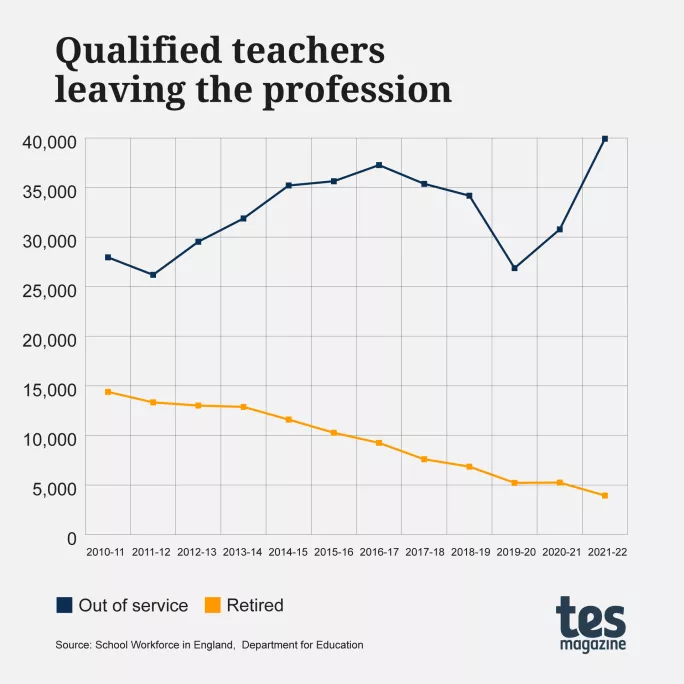Why phased retirement could be key to the workforce crisis

This article was originally published on 23 February 2024
In 2010-11, the number of teachers who reached retirement age was 14,387, according to government data. Fast-forward to 2021-22 and that number had shrunk to just 3,929.
Clearly seeing out your career in education has become less popular. Indeed, as Tes explored last year, the number of teachers leaving the profession in their fifties has risen hugely in the past decade.

Many will have moved to jobs in other sectors while others will have taken early retirement.
Data from Wesleyan Financial Services, obtained through a freedom of information (FoI) request shared with Tes, shows that the number of teachers taking early retirement was over 5,000 in each of the past five years. That number is now higher than the number of full-term retirees.
This means that many talented and experienced teachers are leaving the profession despite having many working years ahead of them. While for some the lure of early retirement may be too strong, for others it may seem that early retirement is the only option to start enjoying later life rather than waiting to reach full retirement age.
However, there is another, lesser-known retirement option that could help more teachers stay in the profession for longer while also opening the door to the joy of retirement: phased retirement.
How phased retirement for teachers works
Phased retirement means teachers can work fewer days and top up their salary by drawing on their pension.
It works by allowing teachers aged 55 and over to access up to 75 per cent of their benefits - and release a cash lump sum - as long as their pensionable earnings are reduced by at least 20 per cent for at least 12 months, by either reducing working hours or taking on a lower-paid job.
This means that you are still earning take-home pay and making pension contributions even as you start to access your pension.
“Teachers don’t realise they can do phased retirement”
Despite the advantages that this offers, take-up of phased retirement remains low - with data from Wesleyan’s FoI revealing that fewer than 800 teachers in the workforce have used this option in each of the past five years - something that Oonagh Morrison, education specialist financial adviser at Wesleyan, says is due to a lack of awareness.
“In my experience, the reason why more teachers aren’t taking phased retirement is that the information isn’t out there,” she says. “Teachers don’t realise they can do it.”
Lack of awareness
This lack of awareness is a worry, according to the NAHT school leaders’ union, because it compounds the problems of long-serving teachers and leaders leaving the profession and recruitment difficulties.
“Phased retirement offers the possibility of a range of late-career pathways for school leaders, but for some years the Department for Education has struggled to promote this as an alternative to teachers and leaders exiting the profession through early retirement,” an NAHT spokesperson said.
“Many experienced school leaders continue to make plans to retire or leave the profession early, which will further compound challenges to recruit.”
This, however, is not a new problem. In 2018, a DfE report, Teachers Working Longer, concluded that “understanding was poor” regarding phased retirement - something it said was surprising.
“Evidence shows that take-up of phased retirement, which is a form of flexible working, has been low,” it said.
“The low take-up is particularly surprising given that evidence also shows that partial retirement in the years before full retirement is an attractive option for many.”
The joy of a three-day week
One teacher who has benefited from phased retirement is Wayne Dean-Richards, an English teacher at Q3 Academy Tipton in the West Midlands.
After stumbling across information about phased retirement when looking at pension details online, Dean-Richards put in a request to take phased retirement and reduce his teaching load, which was accepted. He now works three days a week.
“Since dropping to part-time I’ve been able to use the extra time off to promote a new book of short stories I’ve written and work on new material, too,” he says.
- Teacher pensions: What you need to know
- Retention crisis: The “motherhood penalty” is driving teachers in their thirties to quit
- Staff shortages: How England lost its teachers - and how it can get them back
Another who has done something similar is Rolf Purvis, executive headteacher of Witchford Village College in Cambridgeshire, part of the Eastern Learning Alliance trust.
Like Dean-Richards, Purvis works three days a week, which he says has given him the flexibility to dedicate more time to his life outside school.
“Having two midweek days where I don’t work allows me to do things I wouldn’t be able to do otherwise,” says Purvis. “I visit my 96-year-old mother, attend my son’s sporting fixtures and support the rest of the family.”
Now he’s started phased retirement, would Purvis recommend it to other older teachers looking for a better work-life balance? Yes, absolutely.
“I would recommend it for those like me who wish to remain working in education into their sixties but feel that a slightly shorter week might provide a more flexible lifestyle,” he says.
The benefits for schools and trusts
Despite Purvis being an advocate, his story also underlines the lack of awareness about the option, as he admits that he only heard of it when speaking to a pension adviser about an unrelated matter.
Yet it seems clear that leaders would do well to make more staff aware of phased retirement, as although it may mean reduced hours for some, this would be better than losing them outright.

Lucy Scott, CEO of Eastern Learning Alliance, a mixed-phase trust comprised of 11 schools and colleges, says phased retirement is something that it has sought to encourage as a clear way to retain staff for as long as possible.
“We work hard to make phased retirement as accessible as possible,” she says. “Our trust staff retention strategy focuses on fully supporting staff in all stages of life to thrive and succeed.”
Scott says the trust’s cohort of phased retirement teachers has become a “hugely valuable resource”. To ensure that staff are aware of the option, the trust offers “pension advice support, alongside flexible and bespoke part-time timetables” to try and accommodate their needs.
Of course, any move to phased retirement means that schools and trusts need to start providing flexible-working options - something that is becoming more prevalent in the sector but that Scott says still has a way to go before it becomes standard.
“If we’re serious about tackling the crisis in teacher recruitment and retention we do need to take a more radical view of how to achieve flexibility for teachers more broadly,” she says.
Making time and space
Scott does acknowledge that “part-time timetabling is renowned for being tricky” but she says collegiate approaches between trusts can help.
“We’ve found that sharing experience and ideas between timetabling teams from different trust settings can be really fruitful in terms of offering alternative perspectives and solutions,” she says.
From her inter-trust work, Scott has adopted a range of different flexible approaches in her trust; for example, using an 80 per cent timetable spread across five days.
Rather than the conventional method of dropping a whole day, teachers can choose to perhaps take two mornings off, or a morning and an afternoon, across the week to suit their needs.
Another idea that has been adopted is a gradual phased retirement, whereby a member of staff slowly eases into full retirement by gradually reducing their timetable across an academic year.
“Having two midweek days where I don’t work allows me to do things I wouldn’t be able to do otherwise”
However, while there are clearly those willing to make phased retirement work, it is worth noting that schools do not have to accept a request for it - although they must provide a business reason if they reject it.
Teachers can also move to a new school on a part-time contract and take phased retirement without ever having been on a full-time contract there.
What’s more, if a teacher drops to part-time and starts phased retirement, and then finds their circumstances change and they no longer want or need to be part-time, they can go back to full-time hours.
“For example, a teacher who perhaps goes part-time to allow them to help with caring responsibilities for a pre-school grandchild can then return to full-time hours if that child then starts school,” says Morrison.
Don’t wait until it’s too late
Given all these benefits, it perhaps seems strange that so few teachers in their later years are taking up this option.
In the previously mentioned DfE report Teachers Working Longer there were recommendations made to the DfE specifying that support in the form of training should be offered to school leaders to help them advise older members of staff on their phased retirement options and flexible working.
When Tes asked the DfE if that advice has been followed in the five years since the report was published, it declined to comment.
From people like Dean-Richards, though, the advice to anyone approaching retirement age is to get informed and consider what could work for them.
“The option to take phased retirement and reduce my timetable while being able to supplement my earnings with 75 per cent of my pension is terrific,” he says.
For the latest education news and analysis delivered directly to your inbox every weekday morning, sign up to the Tes Daily newsletter
topics in this article



